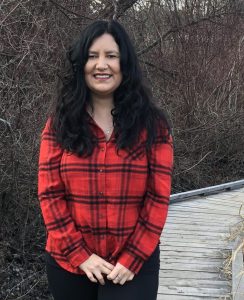 Alice Hird
Alice Hird
My name is Alice Hird, I am a proud member of the Ulkatcho Nation. I presently live on the unceded and traditional territory of the Secwepemc Nation. I am a teacher candidate with the Indigenous Teaching Education Program at the University of British Columbia.
Why did you decide to become a teacher?
In a broad sense, my educational journey led me to become a teacher because of my ability to relate to children and be a positive role model. As a teacher, I want to make a difference in the classroom and maintain a safe environment for learning. My goal is to help students learn to the best of their ability and to ensure that every student has the right to be heard. Effective teaching begins with the teacher’s ability to be open-minded and believe in his/her teaching capabilities. In my classroom, I will promote a sense of inclusion and allow children to learn from their mistakes. As a teacher, I want to incorporate my First Nation culture into the classroom and be open to learning about other students’ ethnic backgrounds. Its important to be dedicated to learning and build relationships with students. I look forward to engaging students in learning and demonstrate strong communication skills. Providing good classroom management skills and provide an overall sense of respect in the classroom is vital in my teaching profession. I will incorporate the First Nations Principles of Learning into my classroom and teach from a two-eyed seeing perspective.
What kind of teacher do you want to be?
I want to focus on being a social and emotional teacher so that all students can get the most out of their class experiences. For example, greeting every student in the morning before they enter my classroom and have them show me from the four diagrams on the wall how they are feeling before we start class. This will help establish how their social and emotional needs are being met, and it will help me to identify any behavior that a student is displaying in class. In my classroom there will be circle time implemented or a campfire that allows students to be able to take their turn and discuss their favorite part of their day before they head home for the day. I want an open-door policy in my classroom so that students feel comfortable coming to discuss anything with me. In the classroom, I would like to do a behaviorist approach and use positive reinforcement such as movie dates, computer time, and more outside time at recess.
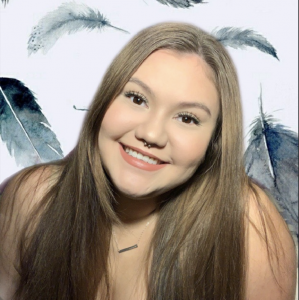
Alyssa Mortensen
Hello, my name is Alyssa Mortensen and I am 23 years old. I am a proud member of the Wet’suwet’en Nation, more specifically Hagwilget Village in Hazelton, BC but I currently reside in Quesnel, BC. I am enrolled in my final year of the NITEP Bachelor of Education program at UBC through the Cariboo Cohort. For the past year and a half I have worked as an Indigenous Education Support Worker at my local school district which has only enhanced my desire to become a teacher.
What does NITEP mean to you?
The NITEP program means support, inclusion, and celebration where we all form by bringing together our understandings to create a powerful force of Indigenous knowledge and practices. NITEP is much like a puzzle, where each individual brings a piece to add to the picture and creating a beautifully unique experience. We work together as group through the good and the bad, we celebrate our success and support each other when we struggle. NITEP is a family that I am honored to be a part of.
Why is Indigenous education important to you?
Indigenous education is important to me because of the lack of resources available for students and teachers within the school system. Indigenous ways of knowing hold great knowledge and power in cross curricular subjects which should be recognized within the classroom. In acknowledging Indigenous knowledge in education, we are acknowledging: our ancestors, ourselves and our future generations by giving them space to share story. Incorporating Indigenous knowledge into the curriculum is honouring the past while supporting the future, giving all students a safe place for their education.
Instagram: @mortensenalyssa
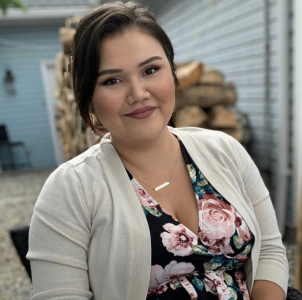
Ashley Bueckert
Hello, my name is Ashley Bueckert. I am a Carrier woman from the Wets’uwet’en Nation in Haqwilget BC, and I am also of Danish descent. I am in my 4th year of the NITEP Bachelor of Education program.
I have a background in Social Work which has greatly contributed to the social emotional aspects of my teaching methods. I am not new to the classroom as I have previously worked as an Education Assistant, Youth Care Worker, and Indigenous Education Support Worker. My personal and professional experiences have created a strong passion to combat historic colonial ideals within education. The traditional approach to education is deeply rooted within historic ideals that intelligence is directly correlated with high percentages and letter grades. This approach to learning has lacked inquiry into students as emotional beings who require nurturing of all aspects of their being to ensure an overall success. To make true connections that exceed past the educator role, such as a safe place or supporter, an educator must step out of that position to practice relationship building skills to establish trust.
Providing a safe space for students will assist them to flourish to their full capacity as they acknowledge the importance of their wellbeing is as much of a priority as a high percentage on an exam. The implementation of land teaching is a positive approach to building positive relationships with students as respect begins deeply rooted in the grounds that continue to nurture the populations that inhabit it. Utilizing a holistic approach derived from Indigenous ideologies encourages reconciliation within the classroom while also promoting humanity as students begin to embrace their emotions and individuality. Incorporating Indigenous pedagogies such as land-based learning and foundation life skills creates a positive shift for the education system and classrooms to support students with positive connections to more than content.
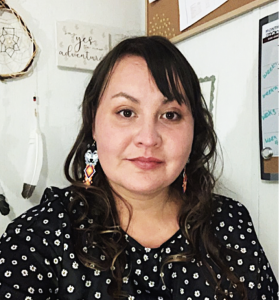
Billi Jean Graham si suboozi
Dahooja (hello),
Billi Jean Graham si suboozi (My name is Billi Jean Graham). Ulkatcho whut’en ‘ust’on hoonust’i’ (I am a proud member of the Ulkatcho Nation). I presently live on the unceded and traditional Tsilhqot’in territory of the Tsi DelDel First Nation. I am currently a fourth-year teacher candidate with the Cariboo Cohort Indigenous Teachers Education Program at the University of British Columbia.
Why did you decide to become a teacher?
My grandmother’s teachings continue to build me up as an Indigenous woman. She taught me to walk through life with my ‘dzi cho’(big heart). I started to work in the schools as an Education Assistant for eight years, and during that time, I learned to use my dzi cho to make small successes for our learners. I had worked with outstanding teachers, and they had pushed me to apply for the NITEP program. The decision to enter the program has changed my life. My greatest honour will be to bring local Indigenous knowledges, teachings and values into our classrooms.
What can you bring to our school that makes you unique?
One of my goals is to create land-based education for elementary students by implementing a Horse Program in my community and decolonize by passing down teachings from our parents, grandparents, and ancestors. Indigenous people have a strong relationship with the land. The land is “A way of thinking, a way of being, a way of understanding and interacting with the world around us.” As an educator, my goal is to emerge local land-based teaching into all curriculum. I will continue to strengthen community collaboration as Tsideldel’s ?esqax nalhiny belh jeneyax Instructor (Redstone Youth Growing Up With Horses Instructor). As a youth horse program instructor, I work with Indigenous youth (ages 4 to 19). The program gives youth empowerment and helps them to form deep connections with their ancestral lands and animals. I will continue to teach our youth life-skills, teamwork, communication, healthy relationships, confidence building, and self-regulation while maintaining a strong connection between horse and rider.
How do you cultivate positive relationships with your students and create a sense of class community?
I plan to build relationships and connections using my ancestral knowledge. I want to use two-eyed seeing by braiding local teachings and SEL into the curriculum to enhance student learning within the classroom. I consistently try to support inclusive teaching with SOGI initiates to support a safer classroom, promoting respect for all culturally, gender diverse learners. When students have a safe environment to learn, there are positive implication for students’ academic and social development. Similarly, humour can solidify relationships, allowing all learners to grow together, alleviate power distances and make learning fun. I have experience with building connections as a Digital mentor, I worked on supporting teacher candidates by enhancing connectedness among the NITEP Cariboo Field Centre. During this role, the focus was on creating a sense of community, digital storytelling activities, land-based activities, and developing skills and leadership capacity through digital media. My teaching philosophy is centered within the connections of land, animals and all learners.
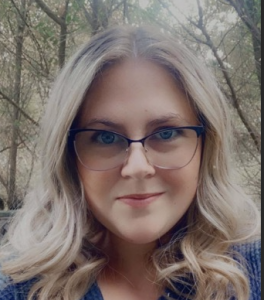
Corly Schmeisser
Weytkp (Hello),
My name is Corly Schmeisser and I am a proud member of the Secwépemc Nation. I presently live on the unceded and traditional territories of the Dakelh People. I am an Indigenous Teacher Candidate and Digital Mentor in the Cariboo Field Centre through the Indigenous Teacher Education Program (NITEP) within the University of British Columbia. I am learning how to bring Indigenous educational approaches which include holistic, land-based, storytelling, social-emotional learning, and cultural aspects into my own teaching practices. I am passionate about Indigenous education and knowledge systems, which can be culturally revitalizing. There is a resurgence in Indigenous communities of their languages and traditions, and in doing so, improve the educational success of Indigenous children and youth.
What can you bring to our school that makes you unique?
Throughout my educational journey at UBC, I gained leadership skills to further develop my education and knowledge as a future teacher. I had a leadership role as a Digital Mentor for the Indigenous Teacher Education Program (NITEP) within the Cariboo Field Centre. In this role, I provided holistic supports to other Indigenous teacher candidates. For instance, I facilitated in person and online sessions on wellness and technology. In addition, I co-presented a workshop titled Digital Mentoring at a Community Field Centre in Indigenous Education at the 2020 Western Canadian Association for Student Teaching (WestCAST) at the University of British Columbia in Vancouver, B.C. Canada. I worked alongside my mentor, Dr. Johanna Sam, throughout the process of creating online modules and activities for The Grease Trail Digital Storytelling Project. I have begun to share about this open access project as a co-author in a peer-reviewed teaching reflection article titled Grease Trail Digital Storytelling Project: Creating Digital Pathways in Teacher Education to be published in KULA: Knowledge, Creation, Dissemination, and Preservation Studies Journal in the special issue on Indigenous knowledges. I continue to share this work at the British Columbia’s Teacher Federation Virtual New Teachers’ Conference on Indigenous Digital Storytelling: A Culturally Revitalizing Assessment Method. I have also created a Curriculum Bundle on Traditional Medicines, which is available for other educators to access on the UBC’s Decolonizing Teaching Indigenizing Learning.
How do you cultivate positive relationships with your students and create a sense of class community?
Creating a sense of community is at the center of my teaching practice. To promote a sense of belonging, I incorporate the First Peoples Principles of Learning in my teaching process. In particular, the FPPL of “Learning ultimately supports the well-being of the self, family, the community, the land, the spirits, and the ancestors” relates to my teaching approach. My teaching practices include health sciences, Indigenous knowledges, and land-based teachings. In classrooms, I aim to incorporate Indigenous pedagogies into my teaching. I utilize Talking Circles, which promotes interconnectedness among learners during a discussion focused on topics relevant to our teachings. The sense of community in the classroom will be promoted by involving community and families, such as, Elders, Storytellers, Knowledge Keepers, and Indigenous Language Teachers. Through dialogue, I give learners an opportunity to reflect on their experiences, learning processes, and educational needs and include holistic perspectives.
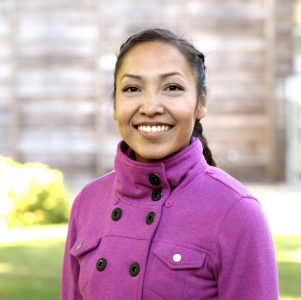
Valarie Johnson
Hello, my name is Valarie Johnson. I am a proud member of the Secwépemc within Esketemc First Nation. I am currently in my fourth and final year in the Bachelor of Education program with UBC’s NITEP – Indigenous Teacher Education Program, Cariboo Field Centre.
In my educational experience, I most enjoyed creating open access learning resources part of The Grease Trail Digital Storytelling project, in particular a podcast titled The Shuswap Sweathouse. For this podcast, I interviewed Secwépemc Elders to learn about the role the sweat lodge in cultural and ceremonial practices. These teachings are available for Elders, public, and other students to listen here. Moreover, I have also created a Curriculum Bundle about the History and Education on Residential Schools. My Curriculum Bundle is available on UBC’s Decolonizing Teaching Indigenizing Learning website here.
During my educational journey, I realized that my own Secwépemc knowledge and community stories have not been fully explored in the school and classroom setting. In addition, there is a pressing need for language resurgence, which can be achieved through land-based histories and stories of the Secwépemc people told by Esketemc people. Land and language are an intimate part of my Indigenous identity and teaching practice. I seek to explore the histories and stories of place and land within Secwepemc territory with the goal of connecting our children to their identity in my teaching approaches.
I have gained leadership experience through a wide variety of community involvement, which includes volunteering with the Alkali Lake youth for sobriety; coordinating karaoke nights, a pow-wow, a drum group; and organizing community Gatherings. Prior to NITEP, I worked for two years at the Sxoxomic Community School at Esketemc in the role of an Educational Assistant. More recently, I received an English and Modern Language Book Award for my analysis of an Indigenous poem. I have been invited to publish my review with ________??. This has led to an invitation from Dr. Rebecca Fredrickson, at Thompson River University, to be a research assistant.
My goal as a lifelong learner and educator is to implement land-based and communal teachings in collaboration with other teachers, local Elders and knowledge keepers, and learners. Realizing that cultural relevance is of great importance, I involve my surrounding community to help guide my teaching practice. The NITEP program has created a pivotal point by which I was given the opportunity to experience a sense of hope. It is through the exploration of self, history, land, resurgence, and language that I became connected to myself, my community and the world around us.